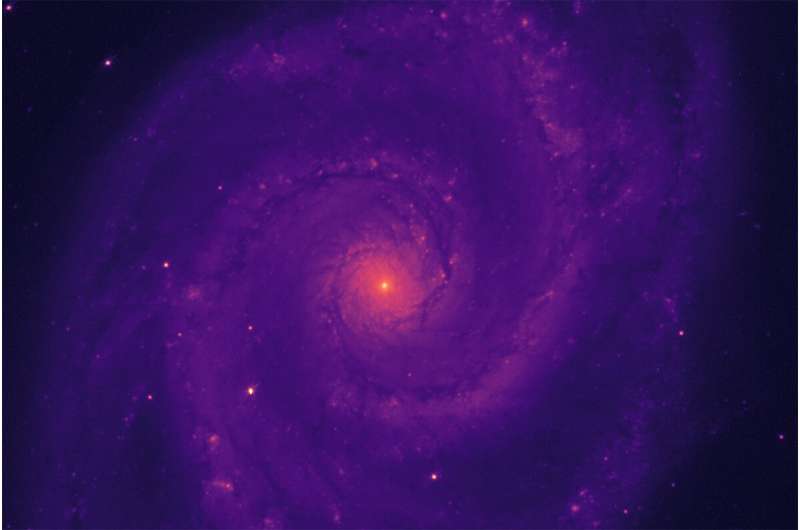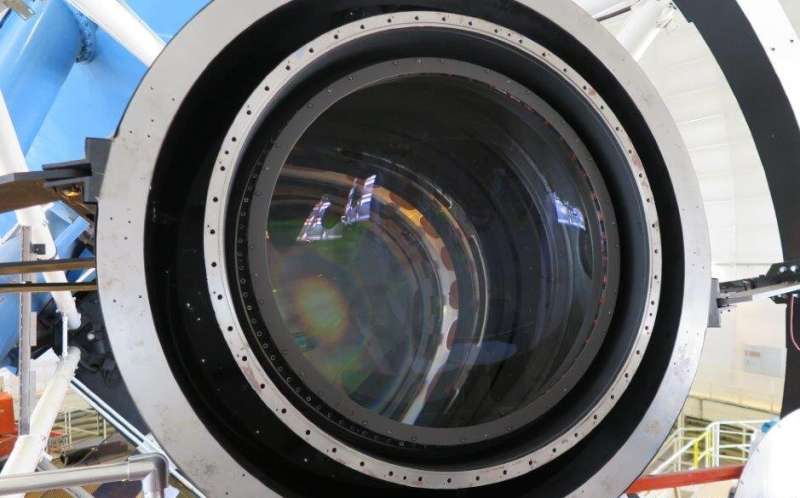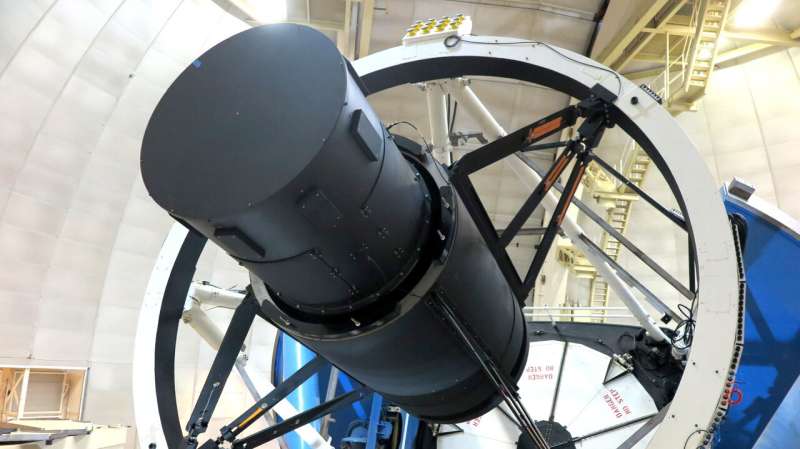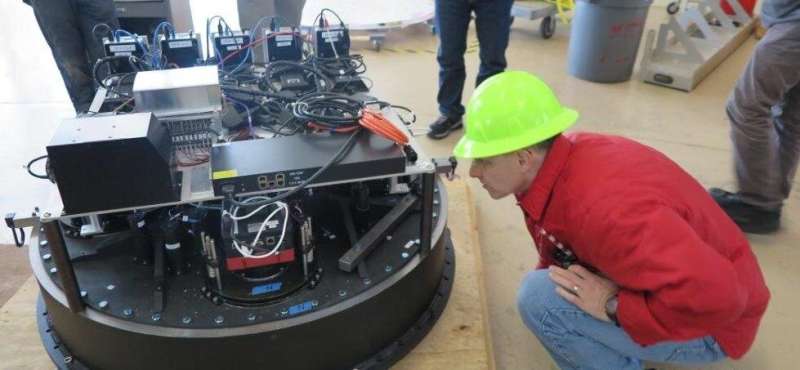Dark Energy Instrument's lenses see the night sky for the first time

On April 1, the dome of the Mayall Telescope near Tucson, Arizona, opened to the night sky, and starlight poured through the assembly of six large lenses that were carefully packaged and aligned for a new instrument that will launch later this year.
Just hours later, scientists produced the first focused images with these precision lenses – the largest is 1.1 meters in diameter – during this early test spin, marking an important "first light" milestone for the Dark Energy Spectroscopic Instrument, or DESI. This first batch of images homed in on the Whirlpool Galaxy to demonstrate the quality of the new lenses.
"It was an incredible moment to see those first images on the control room monitors," said Connie Rockosi, who is leading this early commissioning of the DESI lenses. "A whole lot of people have worked really hard on this, and it's really exciting to show how much has come together already."
This phase of the project will continue for about six weeks and will require the efforts of several onsite scientists and remote observers, noted Rockosi, a professor of astronomy and astrophysics at UC Santa Cruz.
When completed later this year, DESI will see and measure the sky's light in a far different way than this assembly of lenses. It is designed to take in thousands of points of light instead of a single, large picture.
The finished DESI will measure the light of tens of millions of galaxies reaching back 12 billion light-years across the universe. It is expected to provide the most precise measurement of the expansion of the universe and provide new insight into dark energy, which scientists explain is causing this expansion to accelerate.
DESI's array of 5,000 independently swiveling robotic positioners (see a related video: 5,000 Robots Merge to Map the Universe in 3-D), each carrying a thin fiber-optic cable, will automatically move into preset positions with accuracy to within several microns (millionths of a meter). Each positioner is programmed to point its fiber-optic cable at an object to gather its light.
That light will be channeled through the cables to a series of 10 devices known as spectrographs that will separate the light into thousands of colors. The light measurements, known as spectra, will provide detailed information about objects' distance and the rate at which they are moving away from us, providing fresh insight about dark energy.
DESI's lenses are housed in a barrel-shaped device known as a corrector that is attached above the telescope's primary mirror, and the corrector is moved and focused by a surrounding device known as a hexapod.
Fermi National Accelerator Laboratory (Fermilab) researchers led the design, construction, and initial testing of the corrector barrel, hexapod and supporting structures that hold the lenses in alignment.

"Our entire team is pleased to see this instrument achieve first light," said Gaston Gutierrez, the Fermilab scientist who managed this part of the project. "It was a great challenge building such large devices to within the precision of a hair. We're happy to see these systems come together."
The giant corrector barrel and hexapod, which together weigh about 5 tons, must maintain alignment with the telescope's large reflector mirror that is 12 meters below, all while compensating for the movement of the telescope's assemblage of massive components as it swings across the sky.
"This is a big step up. It's a leap into the future for the Mayall Telescope that will enable exciting new scientific discoveries," said Michael Levi, DESI's director and a physicist at the Department of Energy's Lawrence Berkeley National Laboratory (Berkeley Lab), which is the lead institution in the international DESI collaboration. "The team has been working on the new corrector for the past five years, so it was quite an experience seeing $10 million of optics lifted by the crane during installation."
The new set of lenses (see a related video: The Life of a Lens) expands the telescope's viewing window by about 16 times, enabling DESI to map about one-third of the visible sky several times during its five-year mission.
Peter Doel, a professor at University College London, led the team that designed the new optical system. "We had a half-dozen vendors involved with making and polishing the glass. One mistake would have spoiled everything. It's thrilling to know that they survived the journey and work so well."

"This was kind of the moment of truth," said David Schlegel, a DESI project scientist. "We have been biting our nails."
David Sprayberry, the National Optical Astronomy Observatory (NOAO) site director at Kitt Peak, said, "We have an amazing, multitalented team to make sure that everything is working properly," including engineers, astronomers, and telescope operators working in shifts. NOAO operates the Mayall Telescope and its Kitt Peak National Observatory site.
He noted the challenge in updating the sturdy, decades-old telescope, which started up in 1973, with high-precision equipment. "Ultimately we must make sure DESI can target to within 5-micron accuracy – not much larger than a human hair," he said. That's a big thing for something so heavy and big." The entire moving weight of the Mayall Telescope is 375 tons.
Rockosi said there was intensive pre-planning for the corrector's early testing, and many of the tasks during this testing stage are focused on gathering data from evening observations. While DESI scientists have created automated controls to help position, focus, and align all of the equipment, this testing run allows the team to fine-tune these automated tools.
"We'll look at bright stars and test how well we can keep the telescope targeted in the same place, and measure image quality," Rockosi said. "We will test that we can repeatedly and reliably keep those lenses in the best possible alignment."

The precision testing of the corrector is made possible by an instrument – now mounted atop the telescope – that was designed and built by Ohio State University researchers. This 1-ton device, which features five digital cameras and measuring tools supplied by Yale University, and electronics supplied by the University of Michigan, is known as the commissioning instrument.
This temporary instrument was built at the same weight and installed at the same spot where DESI's focal plane will be installed once it is fully assembled. The focal plane will carry DESI's robotic positioners. The commissioning instrument simulates how the telescope will perform when carrying the full complement of DESI components, and is verifying the quality of DESI's lenses.
"One of the biggest challenges with the commissioning instrument was aligning all five cameras with the corrector's curved focal surface," said Paul Martini, an astronomy professor at Ohio State University who led the R&D and installation of the commissioning instrument and is now overseeing its use. "Another was measuring their positions to a few millionths of a meter, which is far more precise than most astronomical instruments." This positioning will ensure truer measurements of the lenses' performance.
He said he is looking forward to the installation of DESI's focal plane later this year. That will pave the way for DESI's official "first light" of its robotic positioners and the start of its galaxy measurements.
"What got me excited about this field in the first place was going to telescopes and taking data, so it will be fun to have this next step," he said.
Provided by Lawrence Berkeley National Laboratory




















